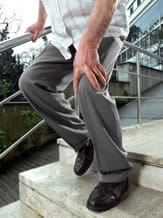Eating well

Osteoarthritic patients who are overweight can obtain advice and support to help them aim at a "normal" weight (see section on Treatments).
In some cases, the use of a dietitian is useful for specific dietary advice. The two complementary and effective ways to lose weight are diet and exercise
In all cases, it is necessary to maintain a balanced diet by at least 3 meals a day, drinking enough and limiting the consumption of sugary and alcoholic beverages.
Exercising well

Exercise is very important for you to avoid losing muscle mass around your joints. Thus, physical activity can help you maintain your muscles during weight loss and thus relieve your joints.
Doing certain movements can relieve your pain and, in some cases, limit the progression of joint damage. You should, nonetheless, consult your doctor to determine the type of exercises you need to do. Indeed, some movements are more beneficial than others.
Studies have thus proved that a decrease in muscle strength of the thigh muscle (quadriceps) precedes the onset of osteoarthritis of the knee (gonarthrosis), and is therefore not a consequence of it.
"Exercising" is therefore essential in osteoarthritis, provided that the exercise is suited to your condition and your abilities. The beneficial effects on joints affected by osteoarthritis are:
- the joints keep their flexibility;
- muscle strength is maintained or even increased;
- joint stability is ensured;
- endurance in everyday activities is improved.
You must therefore keep up a regular exercise routine while avoiding overworking your joints.
Walking at your own pace for at least 1 hour, 3 times a week, provides this joint maintenance and can significantly reduce pain.
In case of pain, do not, however, continue the activity as if nothing has happened: this may aggravate cartilage damage.
In case of a flare-up of osteoarthritis, it is best to restrict your physical activity.
So maintain your activities as much as possible while respecting your pain if it occurs.
Self-monitoring

It can be very helpful if you set-up a self-monitoring plan of your osteoarthritis. You will be able to present and discuss the results of your self assessment with your doctor. The latter can then more easily evaluate the degree of progression of your osteoarthritis and adjust your treatment if necessary.
We suggest you find out about the techniques of self-evaluation via the items proposed in the navigation bar below:
If you notice any changes between two self-assessments, you must consult your doctor.
You have a painful and inflammatory flare-up
We have already seen that pain is a symptom suggestive of a flare-up of osteoarthritis and thus a possible worsening of the osteoarthritic lesions of your joints. However, the difficulty lies in the subjective sense of pain.
So you can help your doctor by quantifying your own pain on a daily basis by attributing a score to it between 0 (no pain) to 10 (extreme pain) and telling him or her during your consultation.
[ Pain Scale ]
It is very important to recognise a flare-up of osteoarthritis as soon as possible because it is often accompanied by phenomena of joint destruction. Thus, to monitor your osteoarthritis, you must be very attentive to signs of a flare-up and see your doctor to make an assessment of your condition if the latter occurs.
The following symptoms often announce a flare-up of osteoarthritis:
- a sudden increase in pain within a few days without apparent cause;
- the onset of night pain;
- stiffness upon awakening lasting more than fifteen minutes;
- the appearance of redness and a feeling of warmth in the joint;
- the appearance of a joint effusion (the joint increases in size).
It is therefore important to distinguish between the symptoms of an osteoarthritic flare-up and normal pain. If you experience these symptoms, you should consult your doctor as he or she will prescribe the necessary treatment, as soon as possible, to relieve your pain and limit the destruction of your cartilage.
In this case, he or she may confirm this diagnosis by prescribing further examinations, but this is not mandatory.
The most useful examination is an X-ray of your joint. Your doctor will be able to compare it to the previous one to see if there is any worsening or not of signs that might indicate an acceleration in cartilage destruction.
Ultrasound (examination currently being assessed for osteoarthritis) is simple, painless, and inexpensive and could, in the future, accompany the X-ray to assess the condition of the joint.
Aspiration of joint fluid can also be carried out. It will relieve you and will ensure that your pain is due to a flare-up of osteoarthritis and not some other disease. This act may precede a corticosteroid injection treatment procedure.
An MRI may be prescribed on an exceptional basis.
You are experiencing functional discomfort

According to the affected joint, osteoarthritis can lead to discomfort or pain that will limit the scope of your movements. The extent of the decrease in your mobility or your difficulty in performing certain tasks can be an effective way to monitor your osteoarthritis.
Indeed, your mobility may reflect the evolution of your osteoarthritic lesions. To monitor your osteoarthritis and especially its impact on reducing your mobility, there are several questionnaires. These evaluation grids generally used by physicians are relevant tools to help you monitor your osteoarthritis.
However, this is not always simple. For some sites, the assessments of your difficulties in some movements do not necessarily reflect the evolution of your osteoarthritis.
It is therefore important to quantify your difficulties frequently with these questionnaires, but you must talk about it regularly with your doctor. By analysing your answers, he or she alone is capable of measuring the evolution of your osteoarthritis and recommending an appropriate treatment for your condition.
We suggest you complete this questionnaire, print it and discuss your results with your doctor.
You are suffering from joint stiffness

Osteoarthritis can cause some stiffness in your joints. The intensity and length of this morning stiffness can often reflect the state of inflammation in your joint. This is frequently observed in inflammatory flare-ups of osteoarthritis.
Regularly assessing the evolution of your stiffness can be a way to monitor your osteoarthritis. As with your functional mobility there are questionnaires (which may be the same) enabling you to regularly quantify the intensity of your stiffness and thus be aware of its progression. However, it is imperative that you discuss the observed results with your doctor. He or she alone is able to analyse the results and judge the evolution of your osteoarthritis.
We suggest you complete this questionnaire, print it and discuss your results with your doctor.















